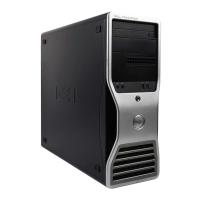2. If a problem is encountered during a test, a message appears with an error code and a description of the problem. Write down the error code and
problem description and follow the instructions on the screen.
3. If you run a test from the Custom Test or Symptom Tree option, click the applicable tab described in the following table for more information.
4. When the tests are completed, if you are running the Dell Diagnostics from the Drivers and Utilities disc, remove the disc.
5. Close the test screen to return to the Main Menu screen. To exit the Dell Diagnostics and restart the computer, close the Main Menu screen.
Power Button Light Codes
The diagnostic lights give much more information about the system state, but legacy power light states are also supported in your computer. The power light
states are shown in following table.
Diagnostic Light Codes
Four (4) single color lights are incorporated on the front control panel to serve as a diagnostic aid for troubleshooting systems exhibiting No Post/No Video
symptoms. The lights do NOT report runtime errors.
Each light has two possible states of OFF or ON. The most significant bit is labeled with the number 1, and the other three are labeled 2, 3, and 4, as you go
down or across the LED stack. The normal operating condition after POST is for all four lights to be ON and then turn off as the BIOS hands over control to the
operating system.
Pre-POST Diagnostic Light Patterns
Displays the results of the test and any error conditions encountered.
Displays error conditions encountered, error codes, and the problem description.
Describes the test and may indicate requirements for running the test.
Displays your hardware configuration for the selected device.
The Dell Diagnostics obtains configuration information for all devices from system setup, memory, and various internal tests, and it displays
the information in the device list in the left pane of the screen. The device list may not display the names of all the components installed on
your computer or all devices attached to your computer.
Allows you to customize the test by changing the test settings.
Power is off, light is blank.
Initial state of light at power up.
Indicates system has power, but the POWER_GOOD signal is not yet active.
If the Hard Drive light is off, it is probable that the power supply needs to be replaced.
If the Hard Drive light on, it is probable that an onboard regulator or VRM has failed. Look at the diagnostic lights for further information.
Second state of the light at power up. Indicates the POWER_GOOD signal is active and it is probable that the power supply is fine. Look at
the diagnostic lights for further information.
System is in a low power state, either S1 or S3. Look at the diagnostic lights to determine which state the system is in.
System is in S0 state, the normal power state of a functioning machine.
The BIOS will turn the light to this state to indicate it has started fetching opcodes.
Light Pattern
( 1 2 3 4 )
1- Off
2- Off
3- Off
4- Off
System is not plugged into AC, PSU is not plugged into system board, or control
panel not connected to system board.
1- Off
2- Off
3- Off
4- Off
ACPI S0; Normal
Operation
System is on with no failures detected. This is actually a BIOS controlled state and is
also S0e.
1- Off
2- Off
3- Off
4- Off
1- Off
2- Off
3- Off
4- Off
Hibernate or Soft off. System plugged in, but either turned off or in Windows
Hibernation State.

